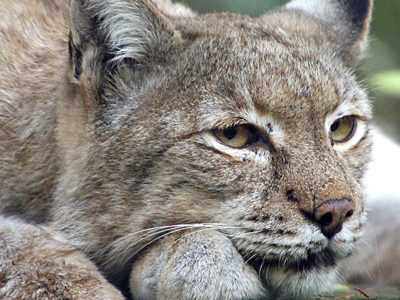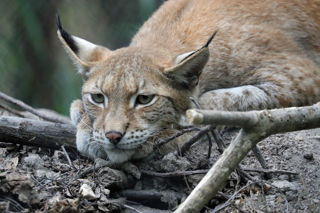
Eurasian Lynx
Lynx lynx lynx
The Eurasian lynx is a medium sized cat, and the largest of the lynx species. They can be found in Europe, Russia and Asia.
Relative to its body size, the Eurasian lynx has long and powerful legs with large, furred 'snowshoe' paws. Lynx have brownish-yellow fur, but this fur can turn greyish in the winter. This colouration of the coat serves as a perfect camouflage.
Behaviour
Like most cat species, lynx are solitary and very secretive. Lynx are nocturnal or crepuscular, normally sleeping during the day.
Lynx scent mark to communicate with other individuals nearby, and to mark out their hunting territories. Lynx are particularly vocal during breeding season, meowing and purring to attract a mate.
UK Status
The Eurasian lynx was exterminated from the UK due to habitat loss and hunting around 1,300 years ago, and is still currently absent in the wild in the UK. There has been increased discussion on reintroducing the lynx to the UK in recent years, following successful reintroduction in other European countries.
Threats
Habitat loss and fragmentation coupled with prey species depletion are major causes for decline. Historically they were also hunted across their range for their fur. In Europe, due to their extensive population recovery since the 1950s, they are protected by CITES and the Berne Convention.

Distribution
Broad distribution, found throughout Europe, and down into central Asia. Their stronghold is through Scandinavia, Russia and Siberia.
Habitat
Clearly seen from its broad distribution, Lynx have the ability to live in a wide variety of different habitats and climates. Normally associated with forested areas (both deciduous and mixed), lynx can also be found in open wooded areas, thick scrub, barren rocky areas, and even semi deserts.
Diet
Predominantly feed on large mammals such as deer, but will hunt smaller animals such as rabbits, wild boar, squirrels and birds.
Wildwood inside information
In our Kent park, we have two lynx named Flossie and Torridon here at the park. The siblings can regularly be seen sunbathing on their platforms.
Family facts
Lynx are Europe’s third largest predator after brown bears and wolves.
-
![Lynx Lying]()
Wildwood animal adoptions last for one year and are the perfect gift for any animal lover. Each adoption helps support our work to save British wildlife. We have different levels of adoption available to suit all occasions and budgets.
ADOPT ME!
-
![Lynx Lying 2]()
Discover the fascinating world of animals through our captivating videos, showcasing their unique behaviours, incredible habitats, and the wonders of nature.
Watch me!


